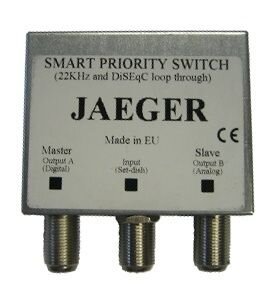Would DC Blocks be helpful in any way to add on any of the lines in the schematics attached?
No, in fact if they were added anywhere, something would stop working.
Another peace is will the motor still draw power from the connected via a splitter receivers, as the Power Inserter appears to act merely as a Voltage Stabilizer having presumably no pass through DC Block? If the motor still draws power from the receiver(s), in what proportion from each?
The DPP44 power inserter is a power inserter. It does not stabilize the voltage coming from the receiver(s). A microscopic amount of power may be drawn from the receiver(s) by the power inserter to detect whether the receiver is turned on or not, but even that would be speculative.
Did you modify your motor such a way that physically cuts power supply from the receiver on its command port?
The point of the mod was precisely to separate these two functions. As a result there is a physical air gap between the command port and the power port. If the motor was to melt down and short, the receiver would be blissfully unaware.
A weak point to recommend others such mod would be not only the warranty loss, but also that various motor makes have different PCBs, so an average FTA fan would rather damage the motor trying to copy someone else's solution, no matter how good the solution is.
The mod was specified to be only for a DG-380. At least one other member has published a similar mod for a different motor. I am not running a kindergarten. If people are bold enough to tackle a mod like this, they need to make a responsible assessment as to whether they are qualified to do it. If they are not and go ahead anyway, it is not a weak point of the mod, merely their judgement.
Anyway, if you're familiar with Six Sigma quality assurance approach, you know what I mean by all these scenarios.
Many people who talk of Six Sigma are unfamiliar with what it really means to achieve this level of reliability. If this is an driving principle in your design, I suggest you reconsider some of your approaches. I respect your choice not to mod your motor. However do not delude yourself into thinking that you will achieve higher reliability through this rationalization. The motor mod is intended to increase reliability by decreasing complexity, eliminating a number of failure modes and restricting damage if certain remaining failure modes happen to occur. The approach you are outlining is weaker in these goals and introduces additional opportunities for failure.
Separately I am not sure where this was left, but it appears you believe the DPP44 power inserter is the best method to supply power to the motor while at the same time passing DiSEqC commands. I have a concern that the DPP44 could in fact provide a higher voltage than is desirable to the motor. Correct me if I'm wrong, but you then interjected that a 18V laptop power supply could be used instead of the DPP44 power inserter's power supply (that's a mouthful). Without a complete tear down and analysis of the DPP44 PI design, I need to warn you that there may be aspects of the implementation that could make this approach a kinetic undertaking. Is all of this trouble and uncertainty better than modding a motor?


